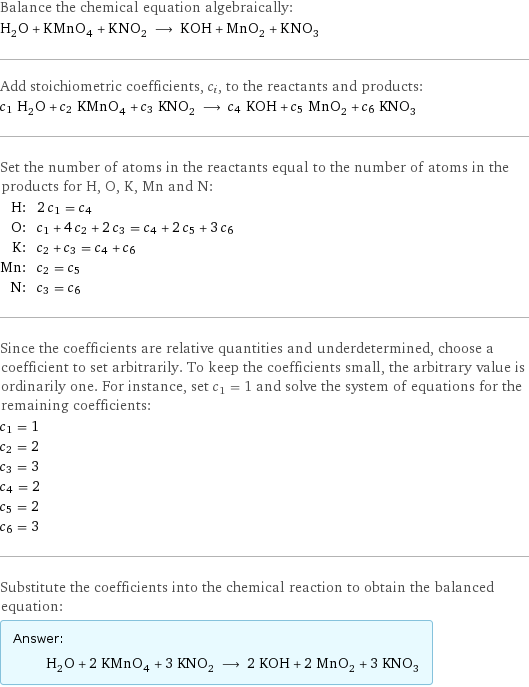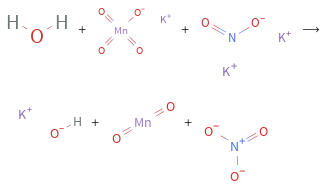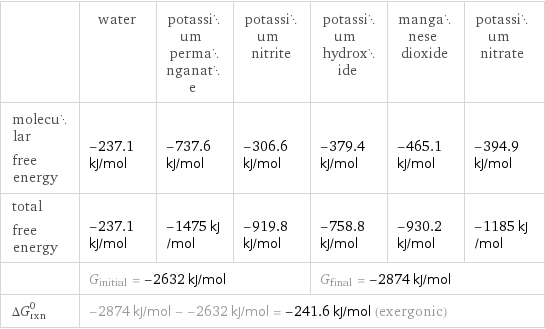Input interpretation

H_2O (water) + KMnO_4 (potassium permanganate) + KNO_2 (potassium nitrite) ⟶ KOH (potassium hydroxide) + MnO_2 (manganese dioxide) + KNO_3 (potassium nitrate)
Balanced equation

Balance the chemical equation algebraically: H_2O + KMnO_4 + KNO_2 ⟶ KOH + MnO_2 + KNO_3 Add stoichiometric coefficients, c_i, to the reactants and products: c_1 H_2O + c_2 KMnO_4 + c_3 KNO_2 ⟶ c_4 KOH + c_5 MnO_2 + c_6 KNO_3 Set the number of atoms in the reactants equal to the number of atoms in the products for H, O, K, Mn and N: H: | 2 c_1 = c_4 O: | c_1 + 4 c_2 + 2 c_3 = c_4 + 2 c_5 + 3 c_6 K: | c_2 + c_3 = c_4 + c_6 Mn: | c_2 = c_5 N: | c_3 = c_6 Since the coefficients are relative quantities and underdetermined, choose a coefficient to set arbitrarily. To keep the coefficients small, the arbitrary value is ordinarily one. For instance, set c_1 = 1 and solve the system of equations for the remaining coefficients: c_1 = 1 c_2 = 2 c_3 = 3 c_4 = 2 c_5 = 2 c_6 = 3 Substitute the coefficients into the chemical reaction to obtain the balanced equation: Answer: | | H_2O + 2 KMnO_4 + 3 KNO_2 ⟶ 2 KOH + 2 MnO_2 + 3 KNO_3
Structures

+ + ⟶ + +
Names

water + potassium permanganate + potassium nitrite ⟶ potassium hydroxide + manganese dioxide + potassium nitrate
Reaction thermodynamics
Gibbs free energy

| water | potassium permanganate | potassium nitrite | potassium hydroxide | manganese dioxide | potassium nitrate molecular free energy | -237.1 kJ/mol | -737.6 kJ/mol | -306.6 kJ/mol | -379.4 kJ/mol | -465.1 kJ/mol | -394.9 kJ/mol total free energy | -237.1 kJ/mol | -1475 kJ/mol | -919.8 kJ/mol | -758.8 kJ/mol | -930.2 kJ/mol | -1185 kJ/mol | G_initial = -2632 kJ/mol | | | G_final = -2874 kJ/mol | | ΔG_rxn^0 | -2874 kJ/mol - -2632 kJ/mol = -241.6 kJ/mol (exergonic) | | | | |
Equilibrium constant
![Construct the equilibrium constant, K, expression for: H_2O + KMnO_4 + KNO_2 ⟶ KOH + MnO_2 + KNO_3 Plan: • Balance the chemical equation. • Determine the stoichiometric numbers. • Assemble the activity expression for each chemical species. • Use the activity expressions to build the equilibrium constant expression. Write the balanced chemical equation: H_2O + 2 KMnO_4 + 3 KNO_2 ⟶ 2 KOH + 2 MnO_2 + 3 KNO_3 Assign stoichiometric numbers, ν_i, using the stoichiometric coefficients, c_i, from the balanced chemical equation in the following manner: ν_i = -c_i for reactants and ν_i = c_i for products: chemical species | c_i | ν_i H_2O | 1 | -1 KMnO_4 | 2 | -2 KNO_2 | 3 | -3 KOH | 2 | 2 MnO_2 | 2 | 2 KNO_3 | 3 | 3 Assemble the activity expressions accounting for the state of matter and ν_i: chemical species | c_i | ν_i | activity expression H_2O | 1 | -1 | ([H2O])^(-1) KMnO_4 | 2 | -2 | ([KMnO4])^(-2) KNO_2 | 3 | -3 | ([KNO2])^(-3) KOH | 2 | 2 | ([KOH])^2 MnO_2 | 2 | 2 | ([MnO2])^2 KNO_3 | 3 | 3 | ([KNO3])^3 The equilibrium constant symbol in the concentration basis is: K_c Mulitply the activity expressions to arrive at the K_c expression: Answer: | | K_c = ([H2O])^(-1) ([KMnO4])^(-2) ([KNO2])^(-3) ([KOH])^2 ([MnO2])^2 ([KNO3])^3 = (([KOH])^2 ([MnO2])^2 ([KNO3])^3)/([H2O] ([KMnO4])^2 ([KNO2])^3)](../image_source/ac8779ea93499a90a3105be9bd1ec574.png)
Construct the equilibrium constant, K, expression for: H_2O + KMnO_4 + KNO_2 ⟶ KOH + MnO_2 + KNO_3 Plan: • Balance the chemical equation. • Determine the stoichiometric numbers. • Assemble the activity expression for each chemical species. • Use the activity expressions to build the equilibrium constant expression. Write the balanced chemical equation: H_2O + 2 KMnO_4 + 3 KNO_2 ⟶ 2 KOH + 2 MnO_2 + 3 KNO_3 Assign stoichiometric numbers, ν_i, using the stoichiometric coefficients, c_i, from the balanced chemical equation in the following manner: ν_i = -c_i for reactants and ν_i = c_i for products: chemical species | c_i | ν_i H_2O | 1 | -1 KMnO_4 | 2 | -2 KNO_2 | 3 | -3 KOH | 2 | 2 MnO_2 | 2 | 2 KNO_3 | 3 | 3 Assemble the activity expressions accounting for the state of matter and ν_i: chemical species | c_i | ν_i | activity expression H_2O | 1 | -1 | ([H2O])^(-1) KMnO_4 | 2 | -2 | ([KMnO4])^(-2) KNO_2 | 3 | -3 | ([KNO2])^(-3) KOH | 2 | 2 | ([KOH])^2 MnO_2 | 2 | 2 | ([MnO2])^2 KNO_3 | 3 | 3 | ([KNO3])^3 The equilibrium constant symbol in the concentration basis is: K_c Mulitply the activity expressions to arrive at the K_c expression: Answer: | | K_c = ([H2O])^(-1) ([KMnO4])^(-2) ([KNO2])^(-3) ([KOH])^2 ([MnO2])^2 ([KNO3])^3 = (([KOH])^2 ([MnO2])^2 ([KNO3])^3)/([H2O] ([KMnO4])^2 ([KNO2])^3)
Rate of reaction
![Construct the rate of reaction expression for: H_2O + KMnO_4 + KNO_2 ⟶ KOH + MnO_2 + KNO_3 Plan: • Balance the chemical equation. • Determine the stoichiometric numbers. • Assemble the rate term for each chemical species. • Write the rate of reaction expression. Write the balanced chemical equation: H_2O + 2 KMnO_4 + 3 KNO_2 ⟶ 2 KOH + 2 MnO_2 + 3 KNO_3 Assign stoichiometric numbers, ν_i, using the stoichiometric coefficients, c_i, from the balanced chemical equation in the following manner: ν_i = -c_i for reactants and ν_i = c_i for products: chemical species | c_i | ν_i H_2O | 1 | -1 KMnO_4 | 2 | -2 KNO_2 | 3 | -3 KOH | 2 | 2 MnO_2 | 2 | 2 KNO_3 | 3 | 3 The rate term for each chemical species, B_i, is 1/ν_i(Δ[B_i])/(Δt) where [B_i] is the amount concentration and t is time: chemical species | c_i | ν_i | rate term H_2O | 1 | -1 | -(Δ[H2O])/(Δt) KMnO_4 | 2 | -2 | -1/2 (Δ[KMnO4])/(Δt) KNO_2 | 3 | -3 | -1/3 (Δ[KNO2])/(Δt) KOH | 2 | 2 | 1/2 (Δ[KOH])/(Δt) MnO_2 | 2 | 2 | 1/2 (Δ[MnO2])/(Δt) KNO_3 | 3 | 3 | 1/3 (Δ[KNO3])/(Δt) (for infinitesimal rate of change, replace Δ with d) Set the rate terms equal to each other to arrive at the rate expression: Answer: | | rate = -(Δ[H2O])/(Δt) = -1/2 (Δ[KMnO4])/(Δt) = -1/3 (Δ[KNO2])/(Δt) = 1/2 (Δ[KOH])/(Δt) = 1/2 (Δ[MnO2])/(Δt) = 1/3 (Δ[KNO3])/(Δt) (assuming constant volume and no accumulation of intermediates or side products)](../image_source/c9dd63ff5f4db7a57efaef72321d97e2.png)
Construct the rate of reaction expression for: H_2O + KMnO_4 + KNO_2 ⟶ KOH + MnO_2 + KNO_3 Plan: • Balance the chemical equation. • Determine the stoichiometric numbers. • Assemble the rate term for each chemical species. • Write the rate of reaction expression. Write the balanced chemical equation: H_2O + 2 KMnO_4 + 3 KNO_2 ⟶ 2 KOH + 2 MnO_2 + 3 KNO_3 Assign stoichiometric numbers, ν_i, using the stoichiometric coefficients, c_i, from the balanced chemical equation in the following manner: ν_i = -c_i for reactants and ν_i = c_i for products: chemical species | c_i | ν_i H_2O | 1 | -1 KMnO_4 | 2 | -2 KNO_2 | 3 | -3 KOH | 2 | 2 MnO_2 | 2 | 2 KNO_3 | 3 | 3 The rate term for each chemical species, B_i, is 1/ν_i(Δ[B_i])/(Δt) where [B_i] is the amount concentration and t is time: chemical species | c_i | ν_i | rate term H_2O | 1 | -1 | -(Δ[H2O])/(Δt) KMnO_4 | 2 | -2 | -1/2 (Δ[KMnO4])/(Δt) KNO_2 | 3 | -3 | -1/3 (Δ[KNO2])/(Δt) KOH | 2 | 2 | 1/2 (Δ[KOH])/(Δt) MnO_2 | 2 | 2 | 1/2 (Δ[MnO2])/(Δt) KNO_3 | 3 | 3 | 1/3 (Δ[KNO3])/(Δt) (for infinitesimal rate of change, replace Δ with d) Set the rate terms equal to each other to arrive at the rate expression: Answer: | | rate = -(Δ[H2O])/(Δt) = -1/2 (Δ[KMnO4])/(Δt) = -1/3 (Δ[KNO2])/(Δt) = 1/2 (Δ[KOH])/(Δt) = 1/2 (Δ[MnO2])/(Δt) = 1/3 (Δ[KNO3])/(Δt) (assuming constant volume and no accumulation of intermediates or side products)
Chemical names and formulas

| water | potassium permanganate | potassium nitrite | potassium hydroxide | manganese dioxide | potassium nitrate formula | H_2O | KMnO_4 | KNO_2 | KOH | MnO_2 | KNO_3 Hill formula | H_2O | KMnO_4 | KNO_2 | HKO | MnO_2 | KNO_3 name | water | potassium permanganate | potassium nitrite | potassium hydroxide | manganese dioxide | potassium nitrate IUPAC name | water | potassium permanganate | potassium nitrite | potassium hydroxide | dioxomanganese | potassium nitrate